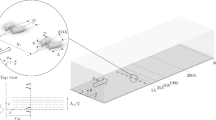Abstract
The vortex structure of the wake behind a marine propeller was investigated in terms of loading variation by using particle image velocimetry. One hundred and fifty instantaneous velocity fields were ensemble averaged to study the spatial evolution of the wake and the behavior of the tip vortices in the region ranging from the trailing edge to one propeller diameter downstream. The trailing vorticity was found to be related to the radial velocity jump, and the viscous wake was affected by the boundary layers developed on the blade surfaces. A vortex identification method using the swirling strength was employed to extract the location of the tip vortex. The loading on the blade made a clear difference to the contraction angles. Slipstream contraction occurred in the very near wake region, and unstable oscillation occurred because of reduced interaction between the tip vortex and the wake sheet behind the maximum contraction point for each loading condition. The maximum tangential velocity around the tip vortex center revealed the average radius of its core, which was used for calculating the vortex strength. Additionally, variation of the average radius of tip vortices with the change of blade loading was related to vortex tube stretching in the wake region. The nearly constant vortex strength continued up to one diameter downstream for light loading and design loading conditions.
Similar content being viewed by others
References
JE Kerwin CS Lee (1978) ArticleTitlePrediction of steady and unsteady marine propeller performance by numerical lifting surface theory Trans SNAME 86 218–253
S Kinnas SW Pyo (1999) ArticleTitleCavitating propeller analysis including the effects of wake alignment J Ship Res 43 IssueID1 38–47
Stella A, Guj G, Di Felice F, Elefante M (1998) Propeller wake evolution analysis by LDV. In: Proceedings of the 22nd symposium on naval hydrodynamics. Aug. 10-14, 1998, Washington, DC, pp 171-180
Chesnakas C, Jessup S (1998) Experimental characterization of propeller tip flow. In: Proceedings of the 22nd symposium on naval hydrodynamics. Aug. 10-14, 1998, Washington, DC, pp 156-169
A Cotroni F Di Felice GP Romano M Elefante (2000) ArticleTitleInvestigation of the near wake of a propeller using particle image velocimetry Exp Fluids 29 S227–236 Occurrence Handle10.1007/s003480070025
SJ Lee BG Paik CM Lee (2004) ArticleTitlePhase-averaged PTV measurements of propeller wake J Ship Res 49 IssueID1 43–54
Calcagno G, Di Felice F, Felli M, Pereira F (2002) Propeller wake analysis behind a ship by stereo PIV. In: Proceedings of the 24th symposium on naval hydrodynamics. July 9-13, Fukuoka, pp 112-127
SJ Lee BG Paik JH Yoon CM Lee (2004) ArticleTitleThree-component velocity field measurements of propeller wake using stereoscopic PIV technique Exp Fluids 36 575–585 Occurrence Handle10.1007/s00348-003-0699-5
BG Paik CM Lee SJ Lee (2005) ArticleTitleComparative measurement on flow structure of marine propeller wake between open free surface and closed surface flows J Mar Sci Tech 10 123–130 Occurrence Handle10.1007/s00773-004-0190-x
F Di Felice D Di Florio M Felli GP Romano (2004) ArticleTitleExperimental investigation of the propeller wake at different loading conditions by particle image velocimetry J Ship Res 48 168–190
Raffel M, Willert C, Kompenhans J (1998) Particle image velocimetry. Springer ISBN 3-540-63683-8
Kline SJ, Robinson SK (1989) Quasi-coherent structures in the turbulent boundary layer. Part I: status report on a community-wide summary of the data. In: Kline SJ, Afgan NH (eds) Near wall turbulence. In: Proceedings of the Zaric memorial conference. Hemisphere, New York, pp 200-217
MS Chong AE Perry BJ Cantwell (1990) ArticleTitleA general classification of three-dimensional flow fields Phy Fluids A2 765–777 Occurrence Handle1050013
J Zhou RJ Adrian S Balachandar (1996) ArticleTitleAutogeneration of near-wall vortical structures in channel flow Phy Fluids 8 288–290 Occurrence Handle1027.76589 Occurrence Handle10.1063/1.868838
Kim J (2002) Sub-visual cavitation and acoustic modeling for ducted marine propulsor. PhD thesis, Dept of Mechanical Engineering, University of Iowa
Author information
Authors and Affiliations
Corresponding author
About this article
Cite this article
Paik, BG., Kim, J., Park, YH. et al. Investigation on the vortex structure of propeller wake influenced by loading on the blade. J Mar Sci Technol 12, 72–82 (2007). https://doi.org/10.1007/s00773-006-0237-2
Received:
Accepted:
Published:
Issue Date:
DOI: https://doi.org/10.1007/s00773-006-0237-2




